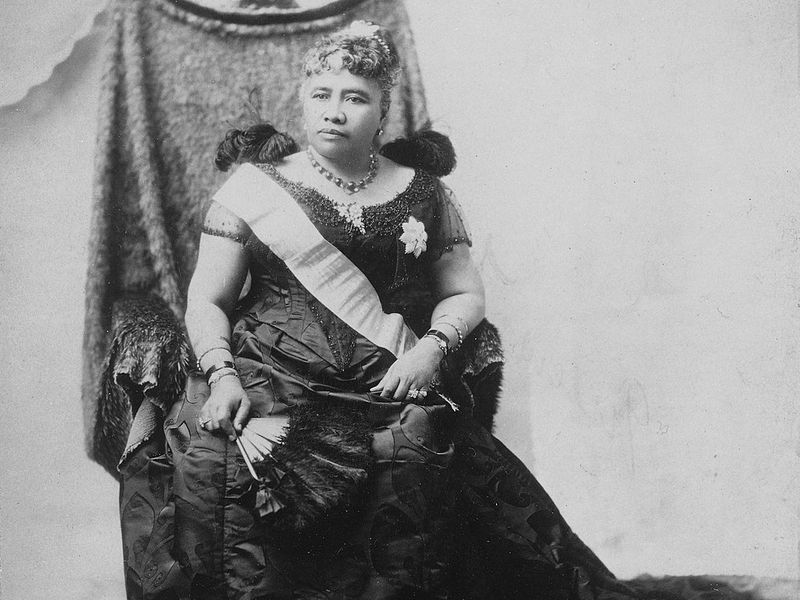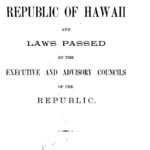Did Hawaii get legally or illegally annexed into the United States of America
Did the USA illegally overthrow the Hawaiian Kingdom, and illegally annex a sovereign nation in 1894? Or was there a legal and valid cession of power via a legitimate treaty that was signed by Queen Liliuokalani?
This is a question that has been analyzed many times by top scholars over the years, especially since the 1993 Apology Resolution given by the then US president Bill Clinton, that “acknowledges that the overthrow of the Kingdom of Hawaii occurred with the active participation of agents and citizens of the United States and further acknowledges that the Native Hawaiian people never directly relinquished to the United States their claims to their inherent sovereignty as a people over their national lands, either through the Kingdom of Hawaii or through a plebiscite or referendum” (U.S. Public Law 103-150 (107 Stat. 1510)).
Although the Blount Report of July 17, 1893, upon which the Apology Resolution was based, was an official report of the U.S. government, it was followed by the Morgan Report on February 26, 1894, which after public hearings and testimony under oath found the Blount Report to be mistaken on many of the facts reported. Some of the criticisms of the Blount Report included the fact that it was done in secrecy, with no opportunity for cross-examination of witnesses and no witnesses placed under oath. Opponents of the Apology Resolution point to this official repudiation of the Blount Report as sufficient reason to dismiss any conclusions based on it. Despite being staunchly in favor of reinstating the monarchy, President Grover Cleveland also reversed himself upon receipt of the Morgan Report, refusing requests from the queen for further aid in her restoration, and acknowledging both the Provisional Government and the Republic of Hawaii as the legitimate successors to the Kingdom.
Washington-based constitutional lawyer and Grassroot Institute of Hawaii consultant Bruce Fein has outlined a number of counterarguments challenging the historical accuracy and completeness of the assertions made in the Apology Resolution.
This is the disputed annexation:
Hamilton Library at the University of Hawaii (Manoa) has several versions of the Constitution of the Republic of Hawaii. For example, they have two different draft versions, three different formattings of the final version, and a final version which incorporates also an account of the proceedings of the constitutional convention. The Constitution was published in 1894 in both Hawaiian and English languages. Click here to download a pdf of a scan of the 53 pages of the final version in English.
Constitution of the Republic of Hawaii 1894
This is a secondary source of the same document: https://disruptarian.com/wp-content/uploads/2018/10/ROHConst.pdf
1
At the end of the Constitution, there were also pages 54-56 comprising the certification of the Constitution — especially interesting because of the names of at least five ethnic Hawaiians who were members of the Constitutional Convention. Below the copied text of the 3-page certification are some historical/political comments by website editor Ken Conklin.
[start page 54]
The Constitutional Convention, convened in Honolulu, Island of Oahu, Hawaiian Islands, on 30th day of May, A.D. 1894, pursuant to the provisions of Act 69 of the Acts of the Provisional Government of the Hawaiian Islands, entitled “An Act to Provide for a Constitutional Convention,” approved the 15th day of March, A.D. 1895 and pursuant to the Proclamation of the President summoning said Convention to assemble, having framed and adopted the Constitution herein before set forth; now it is hereby declared, enacted and proclaimed by the Executive and Advisory Councils of the Provisional Government and by the elected Delegates, constituting said Constitutional Convention, that on and after the Fourth day of July, A.D. 1894, the said Constitution shall be the Constitution of the Republic of Hawaii and the Supreme Law of the Hawaiian Islands.
Done in Convention by unanimous consent this third day of July, A.D. One thousand eight hundred and ninety-four. In witness whereof we have hereunto subscribed our names.
SANFORD B. DOLE,
President of the Provisional Government
WILLIAM CHAUNCEY WILDER,
Vice-President
FRANCIS MARCH HATCH,
Minister of the Interior
WILLIAM OWEN SMITH,
Attorney General
[start page 55]
WILLIAM FESSENDEN ALLEN,
CRISTAL BOLTE,
CECIL BROWN,
JOHN EMMELUTH,
JOHN ENA,
JOHN A. McCANDLESS,
JOSEPH P. MENDONCA,
JAMES FRANCIS MORGAN,
JOHN NOTT,
DAVID BOWERS SMITH,
EDWARD DAVIES TENNEY,
HENRY WATERHOUSE,
ALEXANDER YOUNG,
LEMUEL CLARK ABLES,
HENRY PERRIM BALDWIN,
CHARLES LUNT CARTER,
ANTONIO FERNANDES,
WILLIAM HORNER,
JOSE KEKAHUNA IOSEPA,
DAVID HAILI KAHAULELIO,
JOHN WILLIAM KALUA,
JOHN KAUHANE,
ALBERT KUKAILIMOKU KUNUIAKEA,
FREDERICK S. LYMAN,
WILLIAM FAWCETT POGUE,
WILLIAM HYDE RICE,
[start page 56]
ALEXANDER GEORGE MORISON ROBERTSON,
JOHN MARK VIVAS,
ALBERT SPENCER WILCOX,
GEORGE NORTON WILCOX.
Attest:
CHARLES T. RODGERS,
Secretary of Convention.
============
** Comment by website editor Ken Conklin:
Some of today’s Hawaiian sovereignty diehard deadenders like to say that the Republic of Hawaii was created and sustained entirely by Caucasians, and that ethnic Hawaiians refused to participate except under duress. However, there are several names listed above as authors of the Constitution who are clearly ethnic Hawaiian.
JOSE KEKAHUNA IOSEPA,
DAVID HAILI KAHAULELIO,
JOHN WILLIAM KALUA,
JOHN KAUHANE,
ALBERT KUKAILIMOKU KUNUIAKEA,
Also, in 1894 just as today, some Caucasian-looking names might also belong to ethnic Hawaiians (for example, the leader of the attempted counter-revolution of 1895 was an ethnic Hawaiian with the name Robert Wilcox).
After the Constitution was ratified and the Legislature was seated, the speaker of the House of Representatives at the time of annexation (1898) was John Kaulukou. During the reigns of Kalakaua and Liliuokalani he had been a Royalist, serving as marshal, legislator, and judge.
It should be noted that the Constitution of the Republic of Hawaii sets requirements for President, Senator, Representative, and voter eligibility which are the same for all people regardless of race, and that the literacy requirements specify the ability to speak, read and write in either Hawaiian or English with the two languages being on an equal footing. See for example Articles 56, 58, 74. The continuity of sovereignty of Hawaii as an independent nation flowed smoothly from the Kingdom through the Provisional Government to the Republic. Government laws, private property, treaties with foreign nations, etc. were all confirmed by the Constitution; see for example Articles 92, 93, 95, 95. Article 95 is of special interest today, since it identifies the former Crown lands to have been formerly, and continuing now in 1894, the property of the government and able to be sold without any restriction.
==================
Send comments or questions to:
[email protected]
For further review, I have found photographs of the original letters of recognition from 20 countries of 4 continents recognizing the Republic Of Hawaii from the late 1800s.
You can see these also at: https://web.archive.org/web/20160403184024/http://historymystery.grassrootinstitute.org/recognition-of-the-republic-of-hawaii/
Recognition of the Republic of Hawaii
LETTERS OF FORMAL DIPLOMATIC RECOGNITION (DE JURE) OF THE REPUBLIC OF HAWAII, RECEIVED FROM AUGUST 1894THROUGH JANUARY 1895. These letters were signed by Emperors, Kings, Queens, Princes, and Presidents, addressed to His Excellency Sanford B. Dole, President of the Republic of Hawaii.
A related webpage explains the historical significance of these letters of recognition and current political implications. By recognizing the Republic as the legitimate government of Hawaii, the worldwide family of nations effectively condoned the revolution of 1893 as having been “legal” under international law, and acknowledged the right of the Republic to offer a treaty of annexation and to make a deal with the U.S. ceding Hawaii’s public lands in return for paying off Hawaii’s national debt. A secessionist claim is analyzed and refuted by these documents — a claim that the Republic had no legitimacy under international law and was merely a puppet regime of the United States. For details please see this article on the historic significance and current political implications of these newly rediscovered letters of international recognition.
The most visually spectacular letters are the ones from China and Russia. The letter from Queen Victoria (Britain) is of great significance because of the special relationship between Britain and the Kingdom of Hawaii from 1778 to 1893, and the special relationship between Queen Victoria and Queen Liliuokalani. The letter from President Grover Cleveland (U.S.) is important because Cleveland had blamed the Hawaiian revolution on the presence of U.S. peacekeepers. Cleveland had tried to destabilize the Provisional Government and restore Liliuokalani to the throne from March through December 1893, but stopped interfering due to Congressional pressure after the Morgan Report (Senate Committee on Foreign Affairs, February 1894) concluded the U.S. had neither conspired in nor assisted the revolution. Liliuokalani’s strongly-worded letter of abdication and oath of loyalty constitute, in effect, a letter from the Kingdom of Hawaii recognizing the Republic as the legitimate government. Thus 19 foreign nations, plus the Kingdom of Hawaii, recognized the Republic of Hawaii as the rightful government under international law.
[table id=2 /]
Abdication document signed by ex-queen Liliuokalani, January 24, 1895 formally giving up the throne and swearing her allegiance to the Republic of Hawaii. Also, Oath of Loyalty to the Republic of Hawaii.
As a followup, Dr. Keanu Sai has rebutted the claims and research of Dr. Kenneth Conklin as inaccurate.
Reference: http://www.hawaiireporter.com/conklins-points-on-hawaii-sovereignty-not-valid/
I was able to get a question about the Hague Convention and the Geneva convention that Dr. Sai has been referencing for years. At the town hall meeting on September 24th 2018 that Mr. Jennifer Ruggles hosted to discuss her protest as a member of the county council of Hawaii, I asked Jennifer Ruggles if the alleged war crimes happened in the late 1800’s, and the Geneva Convention and the Hague convention rules/laws that they are citing were enacted/created many years after the alleged war crimes, then how far back retroactively can these rules/laws apply?
Dr. Sai answered, and despite his answer being fairly long-winded, it basically came down to him stating that “since Hawaii was part of the British Kingdom, Hawaii was recognized as a sovereign nation, and therefore these laws had been codified even for war crimes against sovereign nations that came before the conventions and rules were established”
Here is my question, as well as both Jennifer Ruggles, and Dr. Sai’s response On September 24th 2018;
This is my original video regarding this whole issue, long before I became aware of the protest by Councilwoman Jennifer Ruggles, and before my question at her town hall meeting. This is regarding my place in Hawaii, and my investments here for myself and my family, such as our family home. September 3rd 2018 by Ryan Thompson @ Disruptarian Radio
I will be hosting a radio show to discuss this issue on February 2nd 2018 at 4:20pm (GMT -10) at: https://disruptarian.com/radio
Reference our growing knowledge base on this subject with images from the original documents, and the case law regarding this issue.
As another point of reference, this article will be archived at: www.archive.org
I have also meticulously submitted all of the information listed in this post on archive.org including references and third party sources.









1 Comment